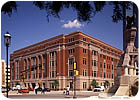
The new Tarrant County Family Law Center in Fort Worth, TX, was designed to reflect the tradition of the city's old courthouse, which stands nearby, but in a more contemporary way. Sunset Red granite - supplied by Cold Spring Granite Co. of Cold Spring, MN - adds texture and architectural detail to the building.
Several considerations were taken into account when planning the design of the new Tarrant County Family Law Center in Fort Worth, TX. Set in close proximity to the historic Tarrant County Courthouse, the design team wanted the new building to be respectful of the 1895 architectural masterpiece. Material selection was an important component in the development of the design for the new building. Given that the old courthouse's exterior walls are clad entirely in a pink Texas granite, one of the design objectives was to utilize granite in the new building as a means of developing a dialogue between the two neighboring structures. As a result, Sunset Red granite - in three finishes - was combined with brick to form the exterior material palette for the Family Law Center.
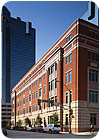
The granite forms the base of the building - spanning 25 feet from the ground to the second floor window. Photos by Steve Hall/Hedrich Blessing Photographers
According to the architect, the design team was looking to use granite for a portion of the building's exterior, but not all of it. “We wanted to be respectful of the old courthouse and deferential to it - not competing with it,†he said. “[Also], this houses an important public institution for the county. We did not want to put it on a pedestal, but we believe courthouses should project a degree of authority. Not in an overassertive way, however; certainly not a building to which families would be coming.â€
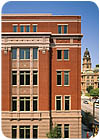
Further detailing the exterior design of the new Family Law Center are polished granite panels containing stylized scales of justice sandblasted into the surface. The old courthouse is shown in the distance, sitting caddy corner across the street from the new building. Photos by Steve Hall/Hedrich Blessing Photographers
Three varying finishes - rock-pitched, polished and thermal jet - were used on the granite, providing texture and depth to the building's design. The polished granite was employed as a base course where the structure meets the sidewalk. Above this, granite coursing continues up the first story of the building in alternating wide and narrow bands with thermal and rock-pitched finishes - wide courses thermal, narrow courses rock-pitched.
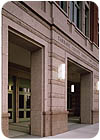
Three varying finishes - rockpitched, polished and thermal jet - were used on the Sunset Red granite. The polished granite was employed as a base course where the structure meets the sidewalk. Above this, granite coursing continues up the first story of the building in alternating wide and narrow bands with thermal and rock-pitched finishes - wide courses thermal, narrow courses rock-pitched.Photos by Steve Hall/Hedrich Blessing Photographers
Further detailing the exterior design of the new Family Law Center are polished granite panels containing stylized scales of justice sandblasted into the surface. Additional panels feature geometric shapes that also create interest and detail.
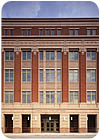
“This is a very different design from the old courthouse,†said Project Architect Michael Swartz of David M. Schwarz / Architectural Services, Inc. “We actually did a lot of work to keep the height of the building down and stay in the cornice line of the old courthouse.â€Photos by Steve Hall/Hedrich Blessing Photographers
“This building is its own style,†Swartz went on to say. “We wanted the references to the old courthouse to be strictly one of the materials - the granite. It has classical references such as the rusticated base, the pilastered bays and main entry facade, the cornice at the fifth floor, and the attic story, but if you look at the details, they are highly stylized and composed of very simple geometric forms.â€
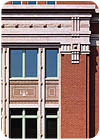
“At the cornice, within the frieze, we introduced a narrow rock-face course that is interrupted with decorative blocks of darker granite cut to form a pointed profile,†said Swartz. Photos by Steve Hall/Hedrich Blessing Photographers
Interior elements
In total, the Tarrant County Family Law Center encompasses 264,000 square feet, including the basement, which contains parking and prisoner holding areas as well as mechanical components. On the upper levels of the building, the use of granite continues - creating an elegant yet functional governmental space.“We wanted to create a pleasant warm interior,†said Swartz. “Granite was used for durability. The public spaces in this building will be heavily used.â€
Atlantic Green granite - also quarried by Cold Spring Granite Co. - was employed as wainscot inside the law center. The material, which was polished, was also used for the base of interior columns. The granite was complemented by a multi-colored, highly patterned, terrazzo floor.
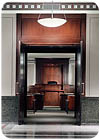
Inside the Tarrant County Family Law Center, Atlantic Green granite - also supplied by Cold Spring Granite Co. - was employed for wainscot. The material was chosen for its sense of permanence and durability.Photos by Steve Hall/Hedrich Blessing Photographers
According to Swartz, windows were placed in all of the district courtrooms. The smaller associate courtrooms, which handle cases shorter in duration, do not have windows for pragmatic reasons, explained the architect. All of the waiting and public circulation areas outside the courtrooms receive abundant daylight via windows and a large, centrally skylit stairway.
In total, it took approximately 14 months to complete the design of the Tarrant County Family Law Center. Construction was finished in about 20 months.
Tarrant County Family Law Center Fort Worth, TX
Architect of Record:Gideon Toal, Forth Worth, TXDesign Architect:David M. Schwarz / Architectural Services, Inc., Washington, DC, and Forth Worth, TX
General Contractor:Gilbane Building Co., Fort Worth, TX
Stone Quarrier/Supplier:Cold Spring Granite Co., Cold Spring, MN
